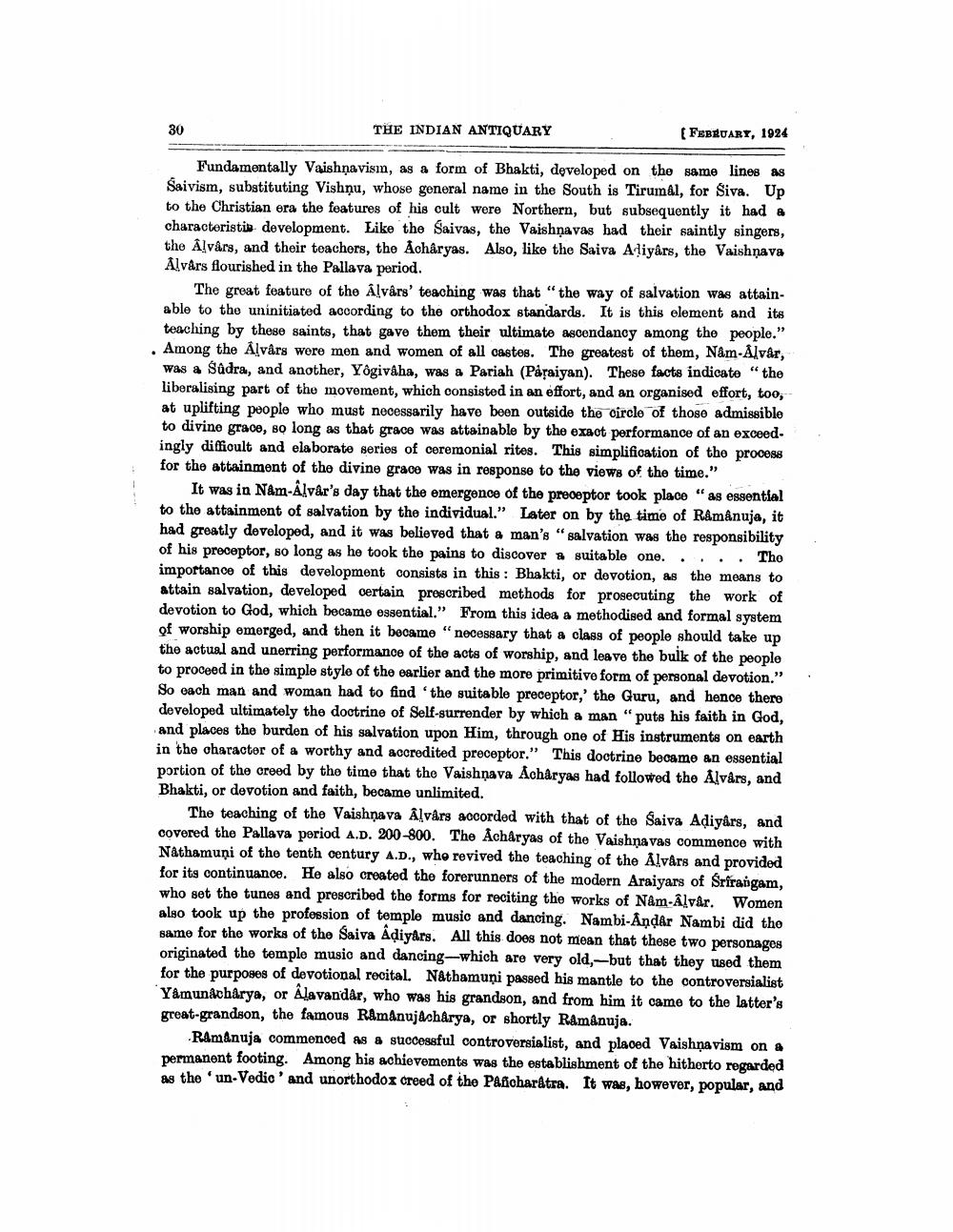________________
THE INDIAN ANTIQUARY
FEBRUARY, 1924
Fundamentally Vaishnavism, as a form of Bhakti, developed on the same lines as Saivism, substituting Vishnu, whose general name in the South is Tirumal, for Siva. Up to the Christian era the features of his cult were Northern, but subsequently it had a characteristib development. Like the Saivas, the Vaishnavas had their saintly singers, the Alvârs, and their teachers, the Acharyas. Also, like the Saiva Aliyârs, the Vaishnava Alvårs flourished in the Pallava period.
The great feature of the Alvârs' teaching was that "the way of salvation was attainable to the uninitiated according to the orthodox standards. It is this element and its teaching by these saints, that gave them their ultimate ascendancy among the people." Among the Alvârs were men and women of all castes. The greatest of them, Nam-Alvår, was a Sadra, and another, Yögivaha, was a Pariah (Paraiyan). These facts indicate "the liberalising part of the movement, which consisted in an effort, and an organised effort, too, at uplifting people who must necessarily have been outside the circle of those admissible to divino grace, so long as that grace was attainable by the exact performance of an exceed. ingly difficult and elaborate series of ceremonial rites. This simplification of the process for the attainment of the divine grace was in response to the views of the time."
It was in Nam-Alvâr's day that the emergence of the preceptor took place "as essential to the attainment of salvation by the individual." Later on by the time of Râmânuja, it had greatly developed, and it was believed that a man's "salvation was the responsibility of his preceptor, so long as he took the pains to discover a suitable one..... The importance of this development consists in this : Bhakti, or devotion, as the means to attain salvation, developed certain prescribed methods for prosecuting the work of devotion to God, which became essential." From this idea a methodised and formal system of worship emerged, and then it became "necessary that a class of people should take up the actual and unerring performance of the acts of worship, and leave the bulk of the people to proceed in the simple style of the earlier and the more primitive form of personal devotion." So each man and woman had to find the suitable preceptor,' the Guru, and hence there developed ultimately the doctrine of Self-surrender by which a man "puts his faith in God, and places the burden of his salvation upon Him, through one of His instruments on earth in the character of a worthy and accredited preceptor." This doctrine became an essential portion of the creed by the time that the Vaishnava Acharyas had followed the Alvars, and Bhakti, or devotion and faith, became unlimited.
The teaching of the Vaishnava Alvårs accorded with that of the Saiva Adiyârs, and covered the Pallava poriod A.D. 200-800. The Acharyas of the Vaishnavas commence with Nathamuni of the tenth century A.D., who revived the teaching of the Alvars and provided for its continuance. He also created the forerunners of the modern Araiyars of Srirangam, who set the tunes and prescribed the forms for reciting the works of Nam-Alvár. Women also took up the profession of temple music and dancing. Nambi-Andar Nambi did the same for the works of the Saiva Adiyars. All this does not mean that these two personages originated the temple musio and dancing-which are very old, but that they used them for the purposes of devotional recital. Nathamuņi passed his mantle to the controversialist YamunAcharya, or Alavandar, who was his grandson, and from him it came to the latter's great-grandson, the famous Ramanuj&charya, or shortly Ramanuja.
Ramanuja commenced as a successful controversialist, and placed Vaishnavism on a permanent footing. Among his achievements was the establishment of the hitherto regarded as the 'un. Vedio' and unorthodox creed of the Pafcharátra. It was, however, popular, and




